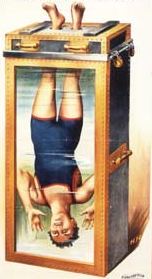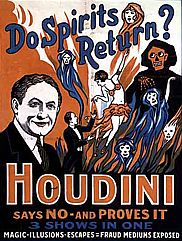|
Harry Houdiniaka Ehrich Weiss Harry Houdini was certainly one of the greatest entertainers the world has ever known. His showmanship and technical virtuosity amazed and delighted huge crowds the world over. But, for that matter, the same could be said of Le Petomane. What made Houdini immortal were his efforts to save the public from their own gullibility, and his genius at self-promotion. Maybe also because death-defying escapes are generally more compelling than your typical fartathon.
Harry Houdini was certainly one of the greatest entertainers the world has ever known. His showmanship and technical virtuosity amazed and delighted huge crowds the world over. But, for that matter, the same could be said of Le Petomane. What made Houdini immortal were his efforts to save the public from their own gullibility, and his genius at self-promotion. Maybe also because death-defying escapes are generally more compelling than your typical fartathon.
It was Houdini's idea to escape from a straightjacket, after watching an inmate struggle to free himself from one in a Canadian madhouse. At first, Houdini performed it behind a screen, emerging near the end to avoid revealing his technique. But he soon changed his mind and started doing it in plain view. The insight here was that the process itself was the captivating part. And though they could see it, people would never be able to replicate the steps. Even if they bothered to get their hands on the equipment to try it themselves, they'd find it impossible without being able to dislocate a shoulder. (Houdini could dislocate both.) His audiences were encouraged to bring their own handcuffs to the show. At a certain point, he would ask those people to come onstage and slap them on him. He would have many pairs around his wrists and forearms, and then extricate himself from inside the privacy of a small box. After one of Houdini's many copycats started offering the same challenge, Houdini wore a disguise to the competitor's show in Berlin. When the guy invited his audience to step right up, Houdini materialized with a nasty pair of double-locking cuffs. It was a lesson in humiliation for the imitator.
He invented the Chinese Water Torture Cell, which involved being submerged upside-down in a glass tank full of water. And the Milk Can escape, where he was locked inside a large metal can, also full of water. And then he would perform a trick where he was buried alive in a coffin inside a larger glass tank filled with dirt. These were all terrific illusions, and widely imitated. But he was best known for being "the original Jail-Breaker" -- able to escape from any locked cell, wearing just underwear, manacles, and leg irons. The local police would search him, lock him in chains, and then toss him in the cell. After they were gone, Houdini would regurgitate a small bindle containing some lockpicks and keys. Once he was free of his physical restraints, he would start work on the cell door. Usually, his arms weren't long enough to reach the door lock from the window opening. But his legs were, and Houdini exploited this fact by teaching himself to pick locks with his feet. Houdini became wildly successful. He was wealthy and famous. So, naturally, he joined the Masons.
So he began to compile information on the subject, and he visited mediums in disguise. He wrote books and articles exposing the frauds. He also began demonstrating their tricks in his act, revealing them as nothing more than stagecraft. It drove the Spiritualists nuts, including Houdini's friend and fellow Freemason Sir Arthur Conan Doyle. Doyle had invented the character Sherlock Holmes, the pure embodiment of logic and rationality. Which makes it weird to learn that Doyle believed in all kinds of ridiculous shit, like the Cottingley Fairies. In fact, Doyle even wrote to Houdini about them:
I have something far more precious: two photos, one of a goblin, the other of four fairies in a Yorkshire wood. A fake! you will say. No, sir, I think not. However, all inquiry will be made. These I am not allowed to send. The fairies are about eight inches high. In one there is a single goblin dancing. In the other four beautiful, luminous creatures. Yes, it is a revelation. So naturally Doyle believed in channeling. His wife was even a spirit medium herself. Doyle was so confident in the existence of supernatural powers that he assumed Houdini was using them to perform his fantastic escapes. He confessed this in a letter to Houdini:
My dear chap, why go around the world seeking a demonstration of the occult when you are giving one all the time? Mrs. Guppy could dematerialize, and so could many folk in Holy Writ, and I do honestly believe that you can also, -- in which case I again ask you why do you want demonstrations of the occult? My reason tells me that you have this wonderful power, for there is no alternative, tho' I have no doubt that, up to a point, your strength and skill avail you. When Houdini finally went after one of Doyle's favorite psychics, the Englishman cut loose in an angry letter to the Boston Herald. Houdini responded in kind:
My opinion of Sir Arthur Conan Doyle is that he is a menace to mankind, because the public thinks that he is just as great a man in (the) spiritualistic field as he is at writing stories. [...] He has not enough mentality left to use good judgment. Harry Houdini died of diffuse peritonitis on Halloween, 1926. Nine days prior, some college boy had repeatedly socked him in the gut. Soon after, he was in a hospital undergoing an emergency appendectomy. During the course of that procedure, the surgeon discovered that Houdini's appendix had been ruptured. But it wasn't the fault of those stomach punches. It turns out that there has never been a case in the medical literature of acute appendicitis resulting from violent trauma to the abdomen. So it was just a coincidence that he had those knuckle sandwiches. Houdini never recuperated, dying in his hospital bed. His wife Bess held an annual seance on the anniversary of Houdini's death, in an attempt to contact the decedent. He and his wife had agreed on a codeword to establish that it was really him and not some lying scumbag medium. To make it impossible for anyone to stumble across the word accidentally, they used a peculiar encoding scheme from an old vaudeville mentalist act.
Three years after Houdini's death, a psychic announced that he had received the secret message. And he was correct. Except that it hadn't come from the spirit world. It turned out that a year earlier, Bess had accidentally leaked the message to some journalists. So much for that. Bess finally gave up trying to contact Harry in 1939. As she reckoned, "Ten years is enough to wait for any man."
Timeline
|
 Houdini made a name for himself by performing dangerous, seemingly impossible, stunts. He would escape from a straightjacket suspended off the side of a skyscraper. He would get thrown into a river locked in chains, sometimes also sealed inside a wooden crate.
Houdini made a name for himself by performing dangerous, seemingly impossible, stunts. He would escape from a straightjacket suspended off the side of a skyscraper. He would get thrown into a river locked in chains, sometimes also sealed inside a wooden crate.
 After his mother died in 1913, Houdini sank into a deep depression. In his grief, he turned to Spiritualism in hopes of a reunion. He visited psychics and mediums around the world, but it became obvious that they were just using standard magic techniques to bilk their customers. It sparked Houdini's outrage that these charlatans would take advantage of people in misery.
After his mother died in 1913, Houdini sank into a deep depression. In his grief, he turned to Spiritualism in hopes of a reunion. He visited psychics and mediums around the world, but it became obvious that they were just using standard magic techniques to bilk their customers. It sparked Houdini's outrage that these charlatans would take advantage of people in misery.